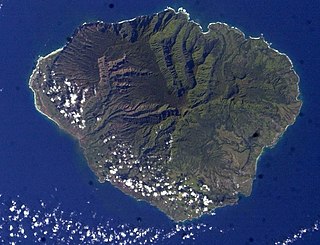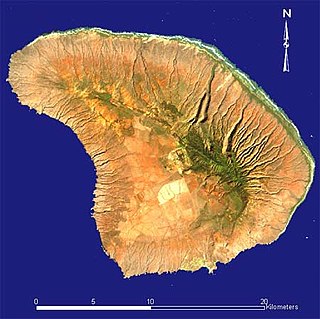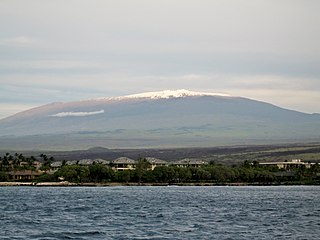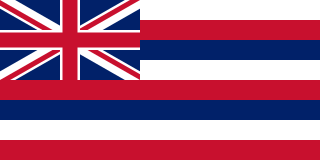External links
- Zimmerman, Elwood C. (1958). Insects of Hawaii. 7 Macrolepidoptera. University of Hawaii Press, Honolulu. hdl:10125/7336.
| This Larentiinae moth related article is a stub. You can help Wikipedia by expanding it. |
| Megalotica aphoristis | |
|---|---|
| Scientific classification | |
| Kingdom: | |
| Phylum: | |
| Class: | |
| Order: | |
| Family: | |
| Genus: | |
| Species: | M. aphoristis |
| Binomial name | |
| Megalotica aphoristis (Meyrick, 1899) | |
| Synonyms | |
| |
Megalotica aphoristis is a moth of the family Geometridae. It was first described by Edward Meyrick in 1899. It is endemic to the island of Hawaii.
It has a bronzy-brown coloration.
Robert Cyril Layton Perkins (1913) noted that this species has been recorded flying during the day and has habits rather similar to those of Megalotica holombra .
| This Larentiinae moth related article is a stub. You can help Wikipedia by expanding it. |

Hawaii is a U.S. state located in the Pacific Ocean. It is the only state outside North America, the only island state, and the only state in the tropics. Hawaii is also one of a handful of U.S. states to have once been an independent nation.

Honolulu is the capital and largest city of the U.S. state of Hawaii, which is located in the Pacific Ocean. It is an unincorporated county seat of the consolidated City and County of Honolulu, situated along the southeast coast of the island of Oʻahu, and is the westernmost and southernmost major U.S. city. Honolulu is Hawaii's main gateway to the world. It is also a major hub for international business, finance, hospitality, and military defense in both the state and Oceania. The city is characterized by an eclectic mix of various Asian, Western, and Pacific cultures, as reflected in its diverse demography, cuisine, and traditions.
Hawaiian is a Polynesian language of the Austronesian language family that takes its name from Hawaiʻi, the largest island in the tropical North Pacific archipelago where it developed. Hawaiian, along with English, is an official language of the State of Hawaii. King Kamehameha III established the first Hawaiian-language constitution in 1839 and 1840.

Oceania is a geographic region that includes Australasia, Melanesia, Micronesia and Polynesia. Spanning the Eastern and Western Hemispheres, Oceania has a land area of 8,525,989 square kilometres (3,291,903 sq mi) and a population of over 41 million. When compared to continents, the region of Oceania is the smallest in land area and the second smallest in population after Antarctica.

Oahu, also known as "The Gathering Place", is the third-largest of the Hawaiian Islands. It is home to roughly one million people—about two-thirds of the population of the U.S. state of Hawaii. The island lies within Honolulu County and the state capital, Honolulu, is on Oahu's southeast coast.

The island of Maui is the second-largest of the Hawaiian Islands at 727.2 square miles (1,883 km2) and is the 17th largest island in the United States. Maui is part of the State of Hawaii and is the largest of Maui County's four islands, which include Molokaʻi, Lānaʻi, and unpopulated Kahoʻolawe. In 2010, Maui had a population of 144,444, third-highest of the Hawaiian Islands, behind that of Oʻahu and Hawaiʻi Island. Kahului is the largest census-designated place (CDP) on the island with a population of 26,337 as of 2010, and is the commercial and financial hub of the island. Wailuku is the seat of Maui County and is the third-largest CDP as of 2010. Other significant places include Kīhei, Lāhainā, Makawao, Pukalani, Pāʻia, Kula, Haʻikū, and Hāna.

Kauaʻi, anglicized as Kauai, is geologically the second-oldest of the main Hawaiian Islands. With an area of 562.3 square miles (1,456.4 km2), it is the fourth-largest of these islands and the 21st largest island in the United States. Known also as the "Garden Isle", Kauaʻi lies 105 miles (169 km) across the Kauaʻi Channel, northwest of Oʻahu. This island is the site of Waimea Canyon State Park.

Hawaiʻi is the largest island located in the U.S. state of Hawaii. It is the largest and the southeasternmost of the Hawaiian Islands, a chain of volcanic islands in the North Pacific Ocean. With an area of 4,028 square miles (10,430 km2), it has 63% of the Hawaiian archipelago's combined landmass, and is the largest island in the United States. However, it has only 13% of Hawaiʻi's people. The island of Hawaiʻi is the third largest island in Polynesia, behind the two main islands of New Zealand.

Hilo is the largest city and census-designated place (CDP) in Hawaii County, Hawaii, United States, which encompasses the Island of Hawaiʻi. The population was 43,263 according to the 2010 census.

Lanai is the sixth-largest of the Hawaiian Islands and the smallest publicly accessible inhabited island in the chain. It is colloquially known as the Pineapple Island because of its past as an island-wide pineapple plantation. The island's only settlement of note is the small town of Lanai City. As of 2012, the island was 98% owned by Larry Ellison, founder and chairman of Oracle Corporation, with the remaining 2% owned by the state of Hawaii and privately owned homes.

The Hawaiian Islands are an archipelago of eight major islands, several atolls, numerous smaller islets, and seamounts in the North Pacific Ocean, extending some 1,500 miles from the island of Hawaiʻi in the south to northernmost Kure Atoll. Formerly the group was known to Europeans and Americans as the Sandwich Islands, a name that James Cook chose in honor of the then First Lord of the Admiralty John Montagu, 4th Earl of Sandwich. The contemporary name, dating from the 1840s, is derived from the name of the largest island, Hawaiʻi Island. The islands were first known to Europeans after the expedition of Álvaro de Saavedra Cerón in 1527.

Mauna Loa is one of five volcanoes that form the Island of Hawaii in the U.S. state of Hawaiʻi in the Pacific Ocean. The largest subaerial volcano in both mass and volume, Mauna Loa has historically been considered the largest volcano on Earth, dwarfed only by Tamu Massif. It is an active shield volcano with relatively gentle slopes, with a volume estimated at approximately 18,000 cubic miles (75,000 km3), although its peak is about 125 feet (38 m) lower than that of its neighbor, Mauna Kea. Lava eruptions from Mauna Loa are silica-poor and very fluid, and they tend to be non-explosive.

Mauna Kea is a dormant volcano on the island of Hawaiʻi. Its peak is 4,207.3 m (13,803 ft) above sea level, making it the highest point in the state of Hawaiʻi. Most of the volcano is underwater, and when measured from its underwater base, Mauna Kea is the tallest mountain in the world, measuring 10,211 m (33,500 ft) in height. Mauna Kea is about a million years old, and has thus passed the most active shield stage of life hundreds of thousands of years ago. In its current post-shield state, its lava is more viscous, resulting in a steeper profile. Late volcanism has also given it a much rougher appearance than its neighboring volcanoes due to construction of cinder cones, decentralization of its rift zones, glaciation on its peak, and weathering by the prevailing trade winds. Mauna Kea last erupted 6,000 to 4,000 years ago and is now considered dormant. The peak is about 38 m (125 ft) higher than Mauna Loa, its more massive neighbor.

Kīlauea is an active shield volcano in the Hawaiian Islands. Historically, Kīlauea is the most active of the five volcanoes that together form the island of Hawaiʻi. Located along the southeastern shore of the island, the volcano is between 210,000 and 280,000 years old and emerged above sea level about 100,000 years ago. The volcano's most recent eruption began on December 20, 2020.

Native Hawaiians are the aboriginal people of the Hawaiian Islands or their descendants who trace their ancestry back to the original Polynesian settlers of Hawaiʻi. The traditional name of the Hawaiian people is Kanaka Maoli.

Pearl Harbor is an American lagoon harbor on the island of Oahu, Hawaii, west of Honolulu. It has been long visited by the Naval fleet of the United States, before it was acquired from the Hawaiian Kingdom by the U.S. with the signing of the Reciprocity Treaty of 1875. Much of the harbor and surrounding lands are now a United States Navy deep-water naval base. It is also the headquarters of the United States Pacific Fleet. The U.S. government first obtained exclusive use of the inlet and the right to maintain a repair and coaling station for ships here in 1887. Its surprise attack by the Imperial Japanese Navy on December 7, 1941, promptly led the United States to declare war on the Empire of Japan making the attack on Pearl Harbor the immediate cause of the United States' entry into World War II.

The Hawaiian Kingdom, or Kingdom of Hawaiʻi, originated in 1795, when the warrior chief Kamehameha the Great, of the independent island of Hawaiʻi, conquered the independent islands of Oʻahu, Maui, Molokaʻi, and Lānaʻi and unified them under one government. In 1810, the whole Hawaiian archipelago became unified when Kauaʻi and Niʻihau joined the Hawaiian Kingdom voluntarily. Two major dynastic families ruled the kingdom: the House of Kamehameha and the House of Kalākaua.

Tulsi Gabbard is an American politician and United States Army Reserve officer who serves as the U.S. Representative for Hawaii's 2nd congressional district. Elected in 2012, she is the first Hindu member of Congress and also the first Samoan-American voting member of Congress. In early February 2019 she announced her candidacy for the Democratic nomination in the 2020 United States presidential election.

Hawaii Five-0 is an American action police procedural television series that centers around a special police major crimes task force operating at the behest of the governor of Hawaii. It is a reboot of the 1968–1980 series Hawaii Five-O, which also aired on CBS. The series was produced by K/O Paper Products and 101st Street Entertainment, initially in association with CBS Productions, then CBS Television Studios starting in season three. The show received praise for its modern take on the original series.
Megalotica holombra is a moth of the family Geometridae. It was first described by Edward Meyrick in 1899. It is endemic to the Hawaiian volcano Haleakalā on the island of Maui.